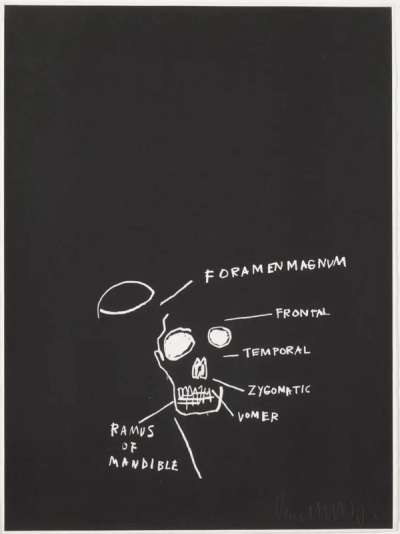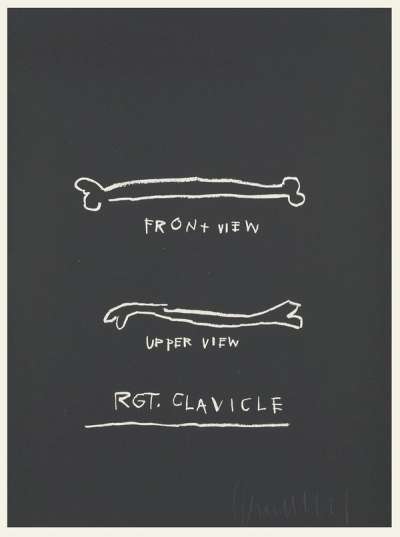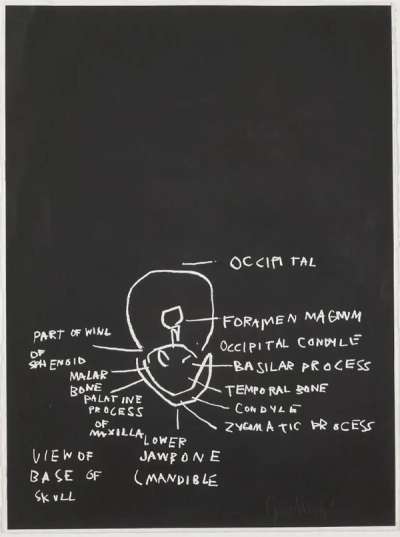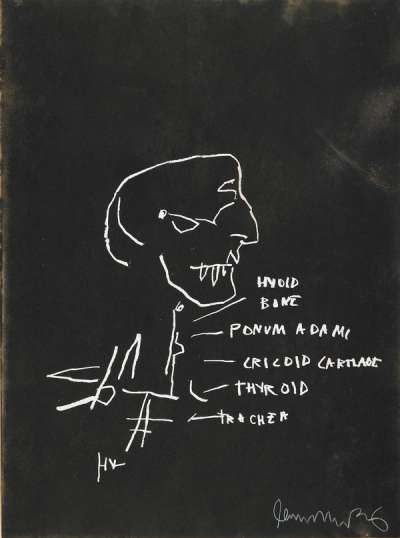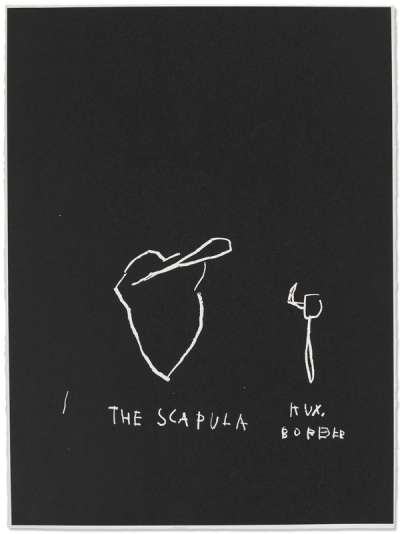 Anatomy, 3 Views Of The Shoulder Joint Opened © Jean-Michel Basquiat 1982
Anatomy, 3 Views Of The Shoulder Joint Opened © Jean-Michel Basquiat 1982
Jess Bromovsky, Sales Director[email protected]
Interested in buying or selling
Jean-Michel Basquiat?

Jean-Michel Basquiat
56 works
Jean-Michel Basquiat, renowned for his raw, yet eloquent works, enters into a realm of quiet introspection with his Anatomy series. This collection holds a striking visual contrast compared to Basquiat’s other works, considering its limited colour palette and equally concise drawings. Rooted in personal experiences—a childhood accident, a gift of Gray's Anatomy from his mother—the Anatomy series goes beyond clinical representation, acting as Basquiat's reflection on existence, identity, and human fragility. While much of his work critiques societal structures, this series offers a momentary respite, urging viewers to marvel at the wonder of the human form. Through Anatomy, Basquiat challenges, enlightens, and invites contemplation on the universal experience of being human.
It has a monochromatic colour palette
 Anatomy, 3 Views Of The Shoulder Joint Opened © Jean-Michel Basquiat 1982
Anatomy, 3 Views Of The Shoulder Joint Opened © Jean-Michel Basquiat 1982Known for his expressive, vibrant canvases, Basquiat makes a deliberate shift to a monochromatic palette in his Anatomy series. Far from diminishing his art, this minimalist approach amplifies it. The stark black and white contrast heightens every detail, proving that simplicity is equally capable of relaying depth and emotion.
Basquiat had a personal collection of Leonardo Da Vinci's manuscripts
 Anatomy, The Scapula © Jean-Michel Basquiat 1982.
Anatomy, The Scapula © Jean-Michel Basquiat 1982.Basquiat's deep immersion in anatomy wasn't solely shaped by his personal experiences with injury. His lens was further refined by his personal collection of Da Vinci's annotated manuscripts. Da Vinci’s work showcased his understanding of the body and desire to preserve its nuances through his sketches. Drawing from both personal experiences and Da Vinci's influence, Basquiat was able to develop his own style that has not only characterised this suite, but additional works be found in celebrity art collections.
Drawing is the sole medium
 Anatomy, Female Pelvis © Jean-Michel Basquiat 1982.
Anatomy, Female Pelvis © Jean-Michel Basquiat 1982.Basquiat's choice to use only drawing for the Anatomy series is both bold and evocative. Drawing, one of the oldest forms of art, strips away the complexities of modern mediums, focusing purely on the intimate connection between the artist's hand and his work. This collection, through its focused approach, highlights the potency of simplicity, suggesting that even basic tools can yield remarkable insights when used under Basquiat.
There’s a literal use of text
 Anatomy, Great Wind Of Sphenoid © Jean-Michel Basquiat 1982.
Anatomy, Great Wind Of Sphenoid © Jean-Michel Basquiat 1982.When viewers engage with Basquiat's art, they often devote as much time to interpreting its meaning as they do to simply admiring it. In Anatomy, Basquiat deviates from this norm. Instead of offering commentary seen in his other works, he employs text in a straightforward manner, providing clear context to the accompanying images, ensuring a cohesive connection between symbols and their intended meanings.
It’s an intersection of life and art
 Anatomy, Left Side Of Jaw © Jean-Michel Basquiat 1982.
Anatomy, Left Side Of Jaw © Jean-Michel Basquiat 1982.A significant car accident in his youth became an unexpected gateway into Basquiat’s love affair with anatomy. Gifted with a copy of Gray's Anatomy by his mother while he was recovering, Basquiat became enamoured with a new, fresh perspective on the body. This immersion helped remedy any physical ailments while fuelling Basquiat's subsequent approach to art.
Basquiat uses anatomy as a narrative tool
 Anatomy, Vertical Median © Jean-Michel Basquiat 1982.
Anatomy, Vertical Median © Jean-Michel Basquiat 1982.Basquiat's art wasn't confined to the boundaries of the Anatomy collection. Across his career, traces of anatomical representation are omnipresent, pointing to the deep-rooted impact of this theme on his creative psyche. It wasn't just a fleeting fascination, but rather a sustained exploration, a lens through which he viewed and expressed his experience. Basquiat’s relationship with bones and emotion continue to prove a compelling agent of storytelling, seen in other collections like Daros and Anatomy Studies. Though different, both rely on the structure of the human form for additional context and commentary to enhance its message.
The complete set is made up of 18 works
 Anatomy, Anterior View © Jean-Michel Basquiat 1982
Anatomy, Anterior View © Jean-Michel Basquiat 1982Comprising a total of 18 works, the Anatomy series offers a comprehensive exploration into Basquiat's engagement with the human form. Each piece, while unique in its representation, collectively embodies the artist's quest to understand and depict the intricacies of the body. The number, though finite, represents a deliberate choice, allowing the viewer to journey through a curated narrative, from one artwork to the next. When more often equates to better, the Anatomy series challenges this notion, proving that depth and meaning can be found in restraint.
It combines medical and artistic interpretation
 Anatomy, Thyroid © Jean-Michel Basquiat 1982.
Anatomy, Thyroid © Jean-Michel Basquiat 1982.Basquiat masterfully combines the clinical precision of medical diagrams with his raw, expressive drawings. To him, the human body is more than mere flesh and bone; but a subject rich with stores of identity, pain, and history. This duality in his work, a blend of the anatomical and the abstract, exalts Basquiat's skill to transform traditional subjects into profound statements.
It's a contrast to sociopolitical narratives
 Anatomy, Head Of The Mandible © Jean-Michel Basquiat 1982.
Anatomy, Head Of The Mandible © Jean-Michel Basquiat 1982.Much of Basquiat's oeuvre is heavily influenced by sociopolitical themes, critiquing systems of racism, colonialism, and power structures. This series, however, offers a temporary reprieve, directing attention instead to the interest of the human form. Yet, in its simplicity, it presents its own subtle challenge: to see the body not as a vessel marked by societal constructs of race and identity but as a marvel of nature and existence. In this shift of focus, Basquiat compels viewers to reconsider the ways in which we perceive and value the human body, independent of external narratives.
It’s a blend of intimacy and detachment
 Anatomy, View Of Base Of Skull © Jean-Michel Basquiat 1982.
Anatomy, View Of Base Of Skull © Jean-Michel Basquiat 1982.Despite the clinical nature of the subject matter, there's an intimacy in Basquiat's Anatomy series that is hard to overlook. Each drawing, while methodical and precise, is filled with a sense of curiosity and wonder, as if Basquiat is rediscovering the human body for himself and inviting the viewer to join him on this journey. This approach stands in contrast to the often detached and impersonal nature of medical illustrations. Through his point of view, Basquiat humanises the body, transforming it from a typical biological structure into a deeply personal and shared experience.

